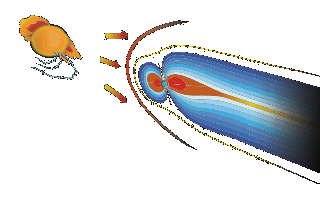|
22 January 1997
A successful prediction of a major space weather storm has been made by a group of international scientists. On 6 January researchers observed a magnetic cloud, produced by a major disturbance on the Sun, heading towards the Earth. It resulted in a significant magnetic storm on 10 January.
|

|
|
The failure of the Telstar 401 broadcast spacecraft occurred in the early hours of Saturday 11th - cutting TV coverage to millions of viewers in the USA. British Antarctic Survey experiments at its Halley Research Station show the storm hit the south polar region early in the morning of 10 January causing disruption to operational communications with field parties and impacting air operations for much of the rest of the day.
The prediction was made at the NASA Goddard Space Flight Center when scientists involved in The International Solar Terrestrial Physics Programme (ISTP) gathered for a workshop meeting. The group use around twenty research spacecraft, a wide range of ground-based research facilities and computer simulations to study solar storms and their effects on the Earth. Scientists watched with excitement as successive research spacecraft and ground-based systems detected the disturbance (known as a coronal mass ejection CME) made its way to Earth and finally give rise to dramatic auroral displays over the Arctic and Antarctic. Present at the meeting was Dr John Dudeney, Head of Upper Atmospheric Research at the British Antarctic Survey and one of four ground-based ISTP Principal Investigators. He says: "It was a very exciting moment - for the first time we were able to see the birth of a space storm and have sufficient instruments in the right places to follow its effects all the way from the explosion on the sun to the final dumping of gigawatts of energy into the Antarctic atmosphere. The unprecedented global coverage we have achieved pushes us a huge step towards providing reliable and practical space weather predictions. People have always been fascinated by the aurora, but even to Victorians it would have only been of academic interest. However, for modern technological society such solar storms can have very significant social and economic impact." Such storms are likely to become more frequent - this one was not particularly large - as the next period of maximum solar activity (which follows an 11 year cycle) approaches at the end of the Millennium. This research is vital in understanding the impacts of space weather and how to mitigate them. The telecommunications, power transmission and insurance industries are impacted by events triggered by such disturbances. Applied research proposals have been prepared for the TSUNAMI initiative led by Dr Dougal Goodman, Deputy Director of BAS, which is seeking to promote and improve transfer of basic science knowledge to industry.
|
|